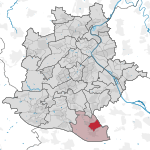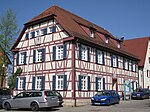Hohenheim Castle
For the district inside the city of Stuttgart, see Hohenheim.Schloss Hohenheim is a manor estate in Stuttgart, eponymous of the Hohenheim city district. The original castle was a fief of the County of Württemberg, recorded for the 12th century. The estate fell into the possession of Charles Eugene, Duke of Württemberg in 1768, who had it re-built as a Rococo style manor with extensive gardens and residential palace for his future wife, Franziska von Hohenheim. The estate was the main ducal residence during 1772–1797, when it fell to the city of Stuttgart. An Agricultural Educational Testing and Model Institution was housed here in 1818, and the estate remains in use by the Horticulture and Agriculture Departments of the University of Hohenheim.
Excerpt from the Wikipedia article Hohenheim Castle (License: CC BY-SA 3.0, Authors).Hohenheim Castle
Emil-Wolff-Straße, Stuttgart Hohenheim (Plieningen)
Geographical coordinates (GPS) Address External links Nearby Places Show on map
Geographical coordinates (GPS)
| Latitude | Longitude |
|---|---|
| N 48.711944444444 ° | E 9.2140555555556 ° |
Address
Schloss Hohenheim
Emil-Wolff-Straße
70599 Stuttgart, Hohenheim (Plieningen)
Baden-Württemberg, Germany
Open on Google Maps









